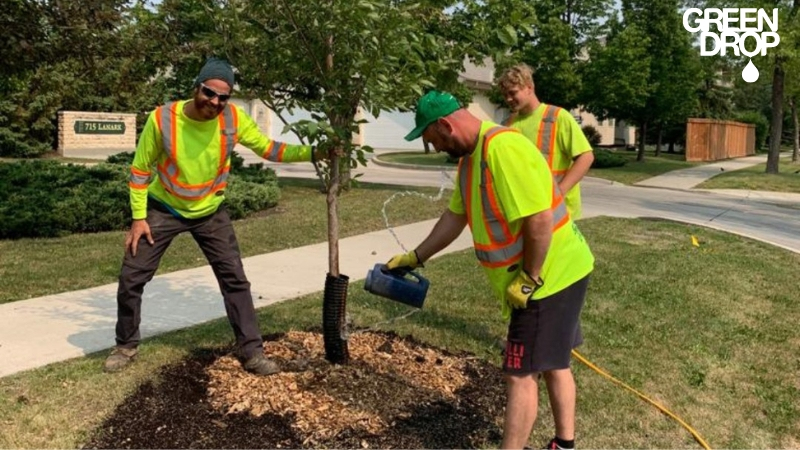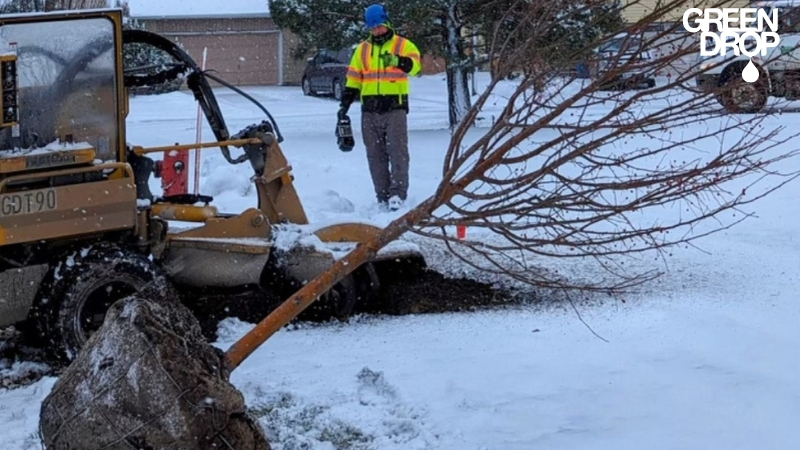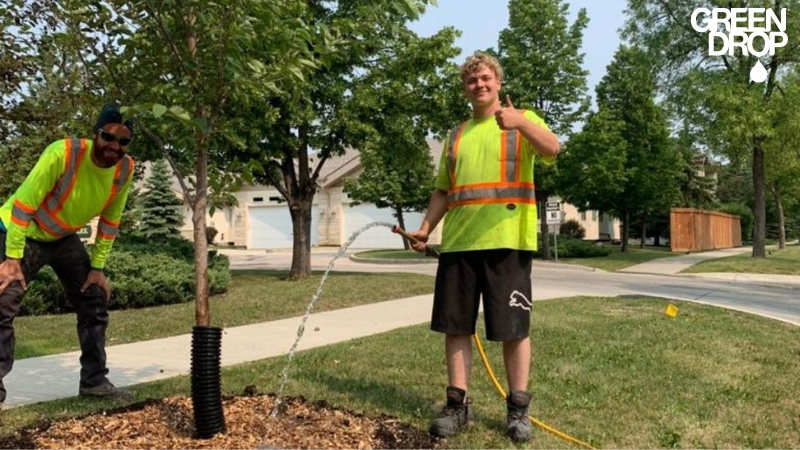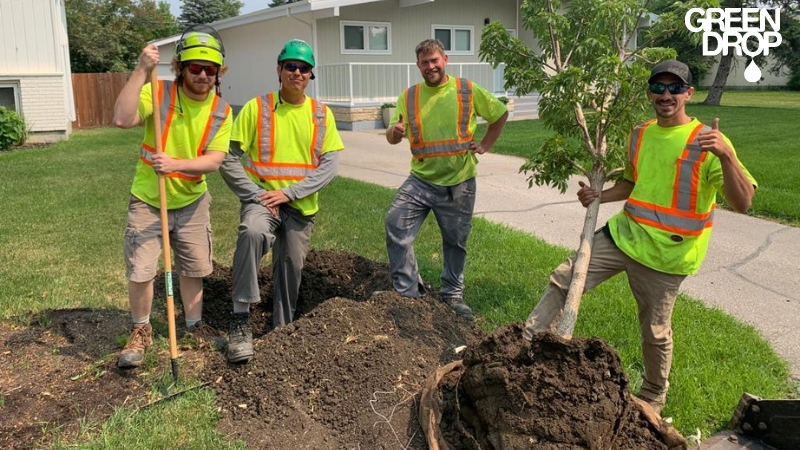Rooted in Success: A Guide to Caring for Newly-Planted and Transplanted Trees in Winnipeg
Reading time: 6 minutesEver felt that jolt of unease when you move to a new place? Trees feel the same way! When newly planted or transplanted, trees experience what we call "transplant shock."
It's tough on them; they experience moving day blues just like us. But don't worry—we've got the scoop on how to ease your trees into their new homes with care that goes beyond dirt and water.
Let’s get to it.

What is Transplant Shock?
Transplant shock is the tree version of a bad moving day. When trees are uprooted and relocated, they can lose, on average 50–75% of their root system, sometimes even up to 95%. This massive upheaval leaves them struggling to absorb water and nutrients efficiently, which is essential for their survival and growth.
Physiologically, this shock can cause a range of symptoms, including leaf wilting, yellowing, reduced leaf size, and slowed growth, as the tree struggles to maintain its basic functions. The root system’s impairment also diminishes the tree’s structural stability, making it more vulnerable to environmental stresses such as strong winds or heavy rain.
Furthermore, the stress from transplant shock can lower a tree's defences against diseases and pests, worsening the challenges it faces. Recovery may not be immediate. It may take several years for a tree to fully overcome transplant shock. During this recovery period, the tree's growth may be stunted, and it may be more sensitive to weather extremes, water shortages, or soil conditions.
The idea here is to provide the right care and intervention to mitigate the effects of transplant shock when moving your tree.

Relocating a Tree in Your Winnipeg Yard
- Pre-Relocation Preparation. Weeks before the move, begin watering the tree more frequently to ensure it's fully hydrated. It may also be necessary to prune the tree (conservatively) to reduce the stress on its canopy. The right season for relocation is early spring or late fall, as the tree is either dormant or just coming out of dormancy.
- Proper Digging Techniques. When excavating a tree, it's vital to preserve a substantial amount of the root ball to sustain the tree during its transition. The size of the root ball should generally be 12 inches in diameter for every inch of trunk diameter. Sharp, clean tools will need to be used to make precise cuts so as to reduce damage to the roots. Keeping the root ball intact and moist is critical during this phase.
- Transporting the Tree. We need to secure the tree and its root ball during transport to prevent any movement that could cause further stress or damage. We wrap the root ball in burlap to maintain moisture and protect the roots.
- Planting Care. Once relocated, plant the tree at the same soil depth it was originally growing, and water it immediately to settle the soil around the roots. Monitor the tree closely for the first few months, adjusting care as needed based on the tree’s response to its new environment. Remember, the tree will need to be replanted within a day or two to avoid planting issues.
How to Keep Your Newly Planted or Transplanted Trees Healthy
1. Proper Watering Techniques
After planting a new tree, one of the most crucial steps to ensure its survival and health is proper watering.
Initially, deep watering is key to encouraging root growth and helping the tree recover from transplant shock. Water daily for the first two weeks to keep the soil consistently moist but not waterlogged.
This frequent watering helps establish the initial root zone in its new environment. After the first two weeks, reduce the frequency to weekly watering, making sure to soak the soil deeply with each session.
This routine should continue until the tree is stronger, which typically takes one growing season. Adjust the schedule based on weather conditions – more frequent watering may be necessary during particularly hot or dry spells.

2. Appropriate Use of Mulch
Mulching is an effective way to maintain moisture levels in the soil and protect the new tree’s root system. Apply a 1–2 inch layer of organic mulch, such as bark or wood chips, around the base of the tree.
This not only helps retain moisture and regulate soil temperature but also suppresses weed growth and reduces competition for nutrients. When applying mulch, be sure to leave a gap of 1–2 inches around the tree trunk. This space prevents moisture build-up against the bark, which can lead to rot and fungal infections.
Extending the mulch out to the tree’s drip line, the outer circumference of the tree’s canopy, ensures that the root area is adequately covered, providing optimal growing conditions.
3. Pruning a Transplanted Tree
Pruning plays a critical role in the health and aesthetics of newly planted and transplanted trees, but it must be done with care and at the right time. In the first year after planting, focus on removing only what’s necessary: dead, broken, or branches that rub against each other. These can create wounds and entry points for pests and diseases.
Avoid heavy pruning or cutting back the canopy significantly during the first year, as this can stress the tree further and slow its recovery from transplant shock. The goal is to allow the tree to focus its energy on establishing roots and adapting to its new location.
Strategic, minimal pruning helps maintain the tree’s structure and health, while excessive cutting can delay its establishment and growth.
4. Staking and Support
Staking newly planted trees can provide necessary stability, especially in windy conditions or when the tree’s root system is not yet strong enough to support its top growth. However, staking should be done judiciously.
Use stakes only when necessary and allow some natural movement of the trunk. This movement stimulates the development of a stronger, more resilient trunk. During staking, place stakes firmly in the ground and tie the tree loosely with broad, flexible straps to avoid damaging the bark or constricting the trunk.
Check the ties regularly as the tree grows, and adjust to ensure they are not too tight, allowing for growth. Typically, stakes can be removed after one to two growing seasons once the tree is stable enough to stand unsupported.
5. Monitoring and Adjusting Watering Needs
You want to continuously assess soil moisture to determine your tree's watering needs. Use a soil probe or simply dig a small hole near the tree to check if the soil is moist but not soggy. Adjust your watering based on the current weather conditions. More frequent during dry, hot spells and less so during rainy periods.
Remember, a tree's water requirements change as it grows and as seasonal conditions shift. Regularly adjusting your watering schedule ensures that your tree receives the right amount of hydration to thrive without the risk of overwatering.
6. Nutrient Management
Fertilization immediately after planting isn't recommended as it can be more harmful than beneficial, potentially leading to root burn while the tree is still fragile.
Wait until a full growing season has passed before introducing fertilizers, and even then, ensure it’s a balanced, slow-release type that matches the tree's specific nutritional needs. Our RootBoost™ provides a fully balanced nutritional plan to support the robust growth of young trees.
7. Regular Inspections for Pests and Diseases
Regularly inspecting your tree for early signs of pests and diseases is crucial in ensuring it stays healthy. Look for changes such as discoloured leaves, unusual leaf drops, or visible damage to the bark.
Early detection of symptoms allows for timely intervention, preventing minor issues from becoming major problems. Incorporate eco-friendly pest management strategies, like using insecticidal soaps or neem oil, which are less harmful to the environment and non-target organisms.

Grow with Green Drop: Expert Tree Care Awaits!
Planting and relocating trees might seem daunting, but with a little expert advice, it can be as easy as walking in the park!
Whether you're sprucing up your yard or giving an old tree a new lease on life, our ISA-certified arborists are here to root for you every step of the way.
Dive into the world of professional tree planting and experience the joy of watching your landscape flourish under expert care.
Schedule a tree care assessment and let our arborists help your garden grow its best in Calgary, Edmonton, Red Deer, Regina, Saskatoon, and Winnipeg.

